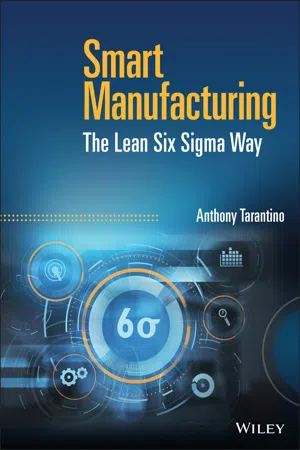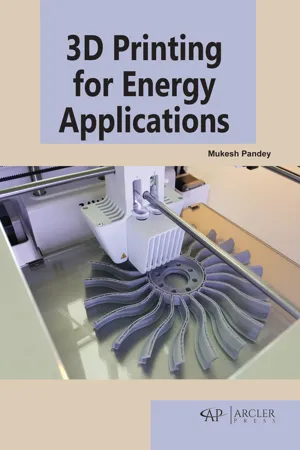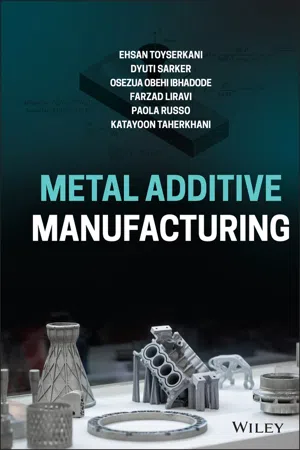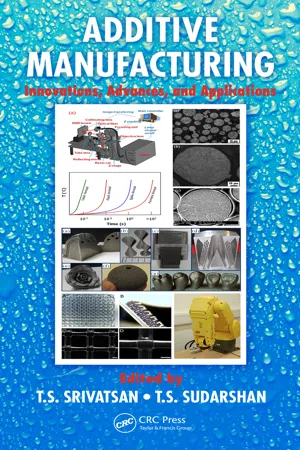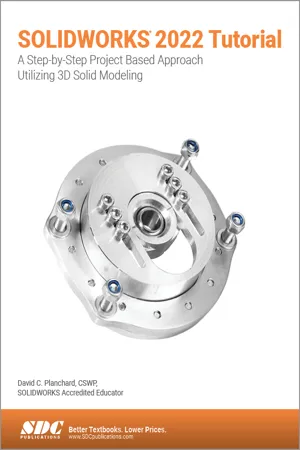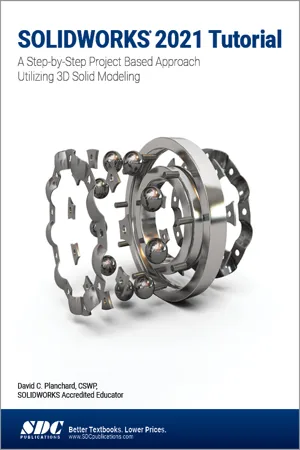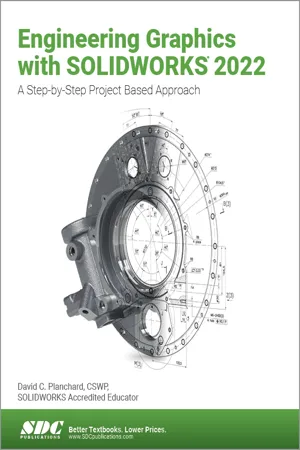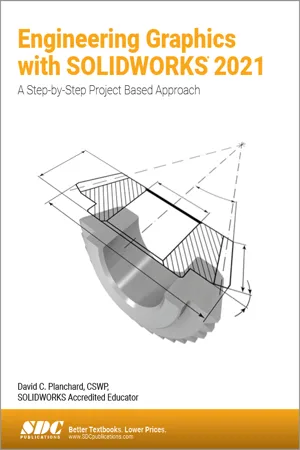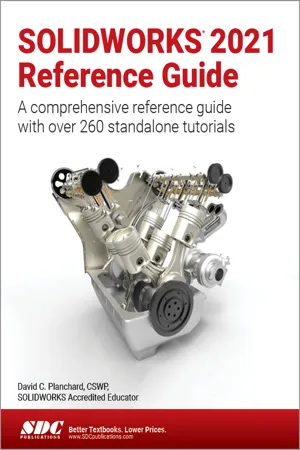Technology & Engineering
Additive Manufacturing
Additive manufacturing, also known as 3D printing, is a process of creating three-dimensional objects by adding material layer by layer. This technology allows for the production of complex and customized parts with reduced waste compared to traditional manufacturing methods. Additive manufacturing is used in various industries, including aerospace, automotive, healthcare, and consumer goods.
Written by Perlego with AI-assistance
Related key terms
1 of 5
10 Key excerpts on "Additive Manufacturing"
- eBook - PDF
Smart Manufacturing
The Lean Six Sigma Way
- Anthony Tarantino(Author)
- 2022(Publication Date)
- Wiley(Publisher)
267 Introduction Additive Manufacturing (AM) is a technology used to create an object from a computer-aided design (CAD) model by adding materials in a layer-by-layer manner (Ngo et al. 2018). This chapter aims to provide a brief introduction to the basic concepts of Additive Manufacturing, the history and current state of this technology, and a description of the methods, materials, and application of this technology in different industries. The first commercialized system for Additive Manufacturing, known as the stereolithogra- phy apparatus (SLA), was developed by Charles Hull in 1986 (Ngo et al. 2018). This system incorporated an ultraviolet (UV) laser to solidify a photo-curable liquid polymer (Bose and Bandyopadhyay 2019). Remarkable developments such as fused deposition modeling (FDM), inkjet printing, and other techniques have been made since the advent of SLA (S. H. Huang et al. 2013). Rapid prototyping (RP) and other terms had been used to represent the various AM processes until the American Society for Testing and Materials (ASTM) Technical Committee agreed on the new term Additive Manufacturing (ASTM International 2012). RP was initially regarded as a process to fabricate a model quickly for the purpose of visualizing a design or creating a rep- resentative example of a final product, and this process has helped engineers to create and analyze the designs they have in mind (Wong and Hernandez 2012). However, since the advent of significant advancements in AM processes, materials, and applications, AM technology is being used not only for the fabrication of prototypes but also for creating final products (Ngo et al. 2018; Vaezi et al. 2013). 3D Printing and Additive Manufacturing Bahareh Tavousi Tabatabaei, Rui Huang, and Jae-Won Choi CHAPTER 12 - eBook - PDF
- Mukesh Pandey(Author)
- 2023(Publication Date)
- Arcler Press(Publisher)
INTRODUCTION 3D PRINTING TECHNOLOGY 1 CONTENTS 1.1 Introduction ........................................................................................ 2 1.2 Additive Manufacturing and its Types ................................................... 4 1.3 Ingredients Utilized for Digital Fabrication Technology in Fabricating Industry ...................................................................... 8 1.4 Digital Fabrication’s Usage in Manufacturing Technology ................. 13 References .............................................................................................. 19 CHAPTER 3D Printing for Energy Applications 2 1.1 INTRODUCTION Through the sequential adding of supplies, physical items from a geometric depiction are fashioned by Additive Manufacturing or 3D printing, also known as digital fabrication technology. High tech which is emerging quite quickly is 3D printing technology. It is high-tech which is extensively utilized everywhere. In the industry of locomotives, in healthcare, aviation industry, and agriculture for open-source designs manufacture, digital fabrication technology is utilized for bulk customization progressively (Saheb & Kumar, 2020). From the prototype of a CAD (computer-aided design), an item’s print can be taken in layers by the removal of material directly through Additive Manufacturing. In the industry of manufacturing, the constituents employed for Additive Manufacturing, its use, and its categories are presented in the paper. Through successively adding ingredients, physical items can be formed through geometric depiction by 3D printing (Shahrubudin et al., 2020). In the current time, remarkable growth has been delegated to this 3D procedure. Charles Hull initially marketed this Additive Manufacturing in 1980 (Gartner et al., 2015). - eBook - PDF
- Ehsan Toyserkani, Dyuti Sarker, Osezua Obehi Ibhadode, Farzad Liravi, Paola Russo, Katayoon Taherkhani(Authors)
- 2021(Publication Date)
- Wiley(Publisher)
1 Additive Manufacturing Process Classification, Applications, Trends, Opportunities, and Challenges Learning Objectives At the end of this chapter, you will be able to: • Understand the standard definition of Additive Manufacturing (AM) and seven standard classes of AM processes • Gain basic knowledge on AM market size • Gain basic knowledge of opportunities, threats, and trends in the AM industry • Gain insight into applications of metal AM 1.1 Additive Manufacturing: A Long-Term Game Changer Additive Manufacturing (AM), also known as 3D printing, is a layer-by-layer fabrication tech-nology “ poised to be one of the most valued forms of manufacturing in history ” [1]. AM is becoming a major research target for industrialized countries as they seek to regain leadership in manufacturing through innovation. The global economy is on the verge of the next industrial revolution, known as “ Industry 4.0 ” , i.e. the fourth industrial revolution. Sector after sector is pulling away from traditional/conventional methods of production in order to engage in and utilize AM. This fresh manufacturing method has garnered a great deal of public curiosity Metal Additive Manufacturing , First Edition. Ehsan Toyserkani, Dyuti Sarker, Osezua Obehi Ibhadode, Farzad Liravi, Paola Russo, and Katayoon Taherkhani. © 2022 John Wiley & Sons Ltd. Published 2022 by John Wiley & Sons Ltd. and international publicity. Every week brings news of novel and astounding AM innovations. This technology, which builds up objects by layers, has piqued the industrialized world ’ s curi-osity and imagination. This public interest was triggered around 2013 – 2014, as shown in Figure 1.1, in which the Google Trend suggests that a public interest in “ 3D Printing ” has been increased more than 50-fold from 2012 to 2016. The trend stays very much the same from 2017 to 2020, but it is the highest in Google Trend compared with counterpart advanced manufac-turing technologies. - eBook - PDF
Additive Manufacturing
Innovations, Advances, and Applications
- T.S. Srivatsan, T.S. Sudarshan, T.S. Srivatsan, T.S. Sudarshan(Authors)
- 2015(Publication Date)
- CRC Press(Publisher)
Referred to as the “third industrial revolu-tion,” 86 Additive Manufacturing has the potential to realize cost-effective mass customization and production of complex products that could not be easily manufactured using any one of the con-ventionally available techniques. With the aid of Additive Manufacturing, products can be easily manufactured 1. In a broad range of sizes (from nanometer to micrometer scale to tens of meters) 2. From a variety of materials (metals, polymers, ceramics, composites, and even biological materials) 3. With numerous functionalities (such as load-carrying brackets, energy conversion struc-tures, and tissue-growing scaffolds) The science and technological capabilities of Additive Manufacturing have made possible its use in a wide spectrum of applications, including the following: 27 Additive Manufacturing of Materials • Cellular machines • Custom medications • Flexible electronics • High-strength, lightweight aerospace structures having material gradients • High-power, high-energy-density microbatteries • Human organs • Multifunctional houses • Products having embedded multi-material sensors and actuators • Turbine blades having internal cavities These applications represent only a few of the opportunities offered by the technological capability and power of Additive Manufacturing to print complex shapes that have a controlled composition and functionality. 85,86 Additive Manufacturing has the potential to produce complex parts using functionally graded materials (FGMs). The ability to deliver different materials to building areas is necessary to build components using FGMs. This is an advantages of Additive Manufacturing that cannot be easily realized using any of the conventional manufacturing methods. 87 Furthermore, additive manufac-turing offers the intrinsic flexibility to control the composition of a part or component to provide multiple functionality. - eBook - PDF
- David C. Planchard CSWP(Author)
- 2022(Publication Date)
- SDC Publications(Publisher)
The exam is out of 100 points. Additive Manufacturing - 3D Printing SOLIDWORKS ® 2022 Quick Start PAGE 7 - 36 Summary Stereolithography (SLA) was the world’s first 3D printing technology. It was introduced in 1988 by 3D Systems, Inc., based on work by inventor Charles Hull. SLA is one of the most popular resin-based 3D printing technologies for professionals today. Selective Laser Sintering (SLS) technology is the most common Additive Manufacturing technology for industrial powder base applications. SLS fuses particles together layer by layer through a high energy pulse laser. Similar to SLA, this process starts with a tank full of bulk material but is in a powder form vs. liquid. Fused filament fabrication (FFF) is an Additive Manufacturing technology used for building three- dimensional prototypes or models layer by layer with a range of thermoplastics. FFF technology is the most widely used form of 3D desktop printing at the consumer level, fueled by students, hobbyists and office professionals. The two most dominant plastics for FFF technology are PLA (Polylactic acid) and ABS (Acrylonitrile-Butadiene- Styrene). With 1000s of hours using multiple low cost FFF 3D printers, we have found that learning about additive print technology is a great experience. Students face a multitude of obstacles with their first 3D prints. Understanding what went wrong and knowing the capabilities of the 3D printer produces positive results. Never focus too much on one single issue. These machines are complex, and trouble often arises from multiple reasons. A slipping filament may not only be caused by a bad gear drive, but also by an obstructed nozzle, a wrong feed value, a too low (or too high) temperature or a combination of all these. Always store filament in an airtight plastic bag (container) with a few silica gel packs. Place the bag in a dry, dark, temperature controlled environment. - eBook - PDF
SOLIDWORKS 2022 Tutorial
A Step-by-Step Project Based Approach Utilizing 3D Modeling
- David C. Planchard CSWP(Author)
- 2022(Publication Date)
- SDC Publications(Publisher)
The exam is out of 100 points. Additive Manufacturing - 3D Printing SOLIDWORKS ® 2022 Tutorial PAGE 11 - 36 Summary Stereolithography (SLA) was the world’s first 3D printing technology. It was introduced in 1988 by 3D Systems, Inc., based on work by inventor Charles Hull. SLA is one of the most popular resin-based 3D printing technologies for professionals today. Selective Laser Sintering (SLS) technology is the most common Additive Manufacturing technology for industrial powder base applications. SLS fuses particles together layer by layer through a high energy pulse laser. Similar to SLA, this process starts with a tank full of bulk material but is in a powder form vs. liquid. Fused filament fabrication (FFF) is an Additive Manufacturing technology used for building three- dimensional prototypes or models layer by layer with a range of thermoplastics. FFF technology is the most widely used form of 3D desktop printing at the consumer level, fueled by students, hobbyists and office professionals. The two most dominant plastics for FFF technology are PLA (Polylactic acid) and ABS (Acrylonitrile-Butadiene- Styrene). With 1000s of hours using multiple low cost FFF 3D printers, we have found that learning about additive print technology is a great experience. Students face a multitude of obstacles with their first 3D prints. Understanding what went wrong and knowing the capabilities of the 3D printer produces positive results. Never focus too much on one single issue. These machines are complex, and trouble often arises from multiple reasons. A slipping filament may not only be caused by a bad gear drive, but also by an obstructed nozzle, a wrong feed value, a too low (or too high) temperature or a combination of all these. Always store filament in an airtight plastic bag (container) with a few silica gel packs. Place the bag in a dry, dark, temperature controlled environment. - eBook - PDF
SOLIDWORKS 2021 Tutorial
A Step-by-Step Project Based Approach Utilizing 3D Modeling
- David C. Planchard CSWP(Author)
- 2021(Publication Date)
- SDC Publications(Publisher)
The exam is out of 100 points. Additive Manufacturing - 3D Printing SOLIDWORKS ® 2021 Tutorial PAGE 11 - 36 Summary Stereolithography (SLA) was the world’s first 3D printing technology. It was introduced in 1988 by 3D Systems, Inc., based on work by inventor Charles Hull. SLA is one of the most popular resin-based 3D printing technologies for professionals today. Selective Laser Sintering (SLS) technology is the most common Additive Manufacturing technology for industrial powder base applications. SLS fuses particles together layer by layer through a high energy pulse laser. Similar to SLA, this process starts with a tank full of bulk material but is in a powder form vs. liquid. Fused filament fabrication (FFF) is an Additive Manufacturing technology used for building three- dimensional prototypes or models layer by layer with a range of thermoplastics. FFF technology is the most widely used form of 3D desktop printing at the consumer level, fueled by students, hobbyists and office professionals. The two most dominant plastics for FFF technology are PLA (Polylactic acid) and ABS (Acrylonitrile-Butadiene- Styrene). With 1000s of hours using multiple low cost FFF 3D printers, we have found that learning about additive print technology is a great experience. Students face a multitude of obstacles with their first 3D prints. Understanding what went wrong and knowing the capabilities of the 3D printer produces positive results. Never focus too much on one single issue. These machines are complex, and trouble often arises from multiple reasons. A slipping filament may not only be caused by a bad gear drive, but also by an obstructed nozzle, a wrong feed value, a too low (or too high) temperature or a combination of all these. Always store filament in an airtight plastic bag (container) with a few silica gel packs. Place the bag in a dry, dark, temperature controlled environment. - eBook - PDF
Engineering Graphics with SOLIDWORKS 2022
A Step-by-Step Project Based Approach
- David C. Planchard CSWP(Author)
- 2022(Publication Date)
- SDC Publications(Publisher)
Total exam time is 60 minutes. You need a minimum passing score of 80 or higher. The exam is out of 100 points. Additive Manufacturing - 3D Printing Engineering Graphics with SOLIDWORKS ® 2022 PAGE 11 - 36 Summary Stereolithography (SLA) was the world’s first 3D printing technology. It was introduced in 1988 by 3D Systems, Inc., based on work by inventor Charles Hull. SLA is one of the most popular resin-based 3D printing technologies for professionals today. Selective Laser Sintering (SLS) technology is the most common Additive Manufacturing technology for industrial powder base applications. SLS fuses particles together layer by layer through a high energy pulse laser. Similar to SLA, this process starts with a tank full of bulk material but is in a powder form vs. liquid. Fused filament fabrication (FFF) is an Additive Manufacturing technology used for building three- dimensional prototypes or models layer by layer with a range of thermoplastics. FFF technology is the most widely used form of 3D desktop printing at the consumer level, fueled by students, hobbyists and office professionals. The two most dominant plastics for FFF technology are PLA (Polylactic acid) and ABS (Acrylonitrile-Butadiene- Styrene). With 1000s of hours using multiple low cost FFF 3D printers, we have found that learning about additive print technology is a great experience. Students face a multitude of obstacles with their first 3D prints. Understanding what went wrong and knowing the capabilities of the 3D printer produces positive results. Never focus too much on one single issue. These machines are complex, and trouble often arises from multiple reasons. A slipping filament may not only be caused by a bad gear drive, but also by an obstructed nozzle, a wrong feed value, a too low (or too high) temperature or a combination of all these. Always store filament in an airtight plastic bag (container) with a few silica gel packs. - eBook - PDF
Engineering Graphics with SOLIDWORKS 2021
A Step-by-Step Project Based Approach
- David C. Planchard CSWP(Author)
- 2021(Publication Date)
- SDC Publications(Publisher)
Total exam time is 60 minutes. You need a minimum passing score of 80 or higher. The exam is out of 100 points. Additive Manufacturing - 3D Printing Engineering Graphics with SOLIDWORKS ® 2021 PAGE 11 - 36 Summary Stereolithography (SLA) was the world’s first 3D printing technology. It was introduced in 1988 by 3D Systems, Inc., based on work by inventor Charles Hull. SLA is one of the most popular resin-based 3D printing technologies for professionals today. Selective Laser Sintering (SLS) technology is the most common Additive Manufacturing technology for industrial powder base applications. SLS fuses particles together layer by layer through a high energy pulse laser. Similar to SLA, this process starts with a tank full of bulk material but is in a powder form vs. liquid. Fused filament fabrication (FFF) is an Additive Manufacturing technology used for building three- dimensional prototypes or models layer by layer with a range of thermoplastics. FFF technology is the most widely used form of 3D desktop printing at the consumer level, fueled by students, hobbyists and office professionals. The two most dominant plastics for FFF technology are PLA (Polylactic acid) and ABS (Acrylonitrile-Butadiene- Styrene). With 1000s of hours using multiple low cost FFF 3D printers, we have found that learning about additive print technology is a great experience. Students face a multitude of obstacles with their first 3D prints. Understanding what went wrong and knowing the capabilities of the 3D printer produces positive results. Never focus too much on one single issue. These machines are complex, and trouble often arises from multiple reasons. A slipping filament may not only be caused by a bad gear drive, but also by an obstructed nozzle, a wrong feed value, a too low (or too high) temperature or a combination of all these. Always store filament in an airtight plastic bag (container) with a few silica gel packs. - eBook - PDF
SOLIDWORKS 2021 Reference Guide
A comprehensive reference guide with over 260 standalone tutorials
- David C. Planchard CSWP(Author)
- 2021(Publication Date)
- SDC Publications(Publisher)
Total exam time is 60 minutes. You need a minimum passing score of 80 or higher. The exam is out of 100 points. Additive Manufacturing - 3D Printing Fundamentals SOLIDWORKS ® 2021 Reference Guide Page 19 - 36 Summary Stereolithography (SLA) was the world’s first 3D printing technology. It was introduced in 1988 by 3D Systems, Inc., based on work by inventor Charles Hull. SLA is one of the most popular resin-based 3D printing technologies for professionals today. Selective Laser Sintering (SLS) technology is the most common Additive Manufacturing technology for industrial powder base applications. SLS fuses particles together layer by layer through a high energy pulse laser. Similar to SLA, this process starts with a tank full of bulk material but is in a powder form vs. liquid. Fused filament fabrication (FFF) is an Additive Manufacturing technology used for building three- dimensional prototypes or models layer by layer with a range of thermoplastics. FFF technology is the most widely used form of 3D desktop printing at the consumer level, fueled by students, hobbyists and office professionals. The two most dominant plastics for FFF technology are PLA (Polylactic acid) and ABS (Acrylonitrile-Butadiene- Styrene). With 1000s of hours using multiple low cost FFF 3D printers, we have found that learning about additive print technology is a great experience. Students face a multitude of obstacles with their first 3D prints. Understanding what went wrong and knowing the capabilities of the 3D printer produces positive results. Never focus too much on one single issue. These machines are complex, and trouble often arises from multiple reasons. A slipping filament may not only be caused by a bad gear drive, but also by an obstructed nozzle, a wrong feed value, a too low (or too high) temperature or a combination of all these. Always store filament in an air-tight plastic bag (container) with a few silica gel packs.
Index pages curate the most relevant extracts from our library of academic textbooks. They’ve been created using an in-house natural language model (NLM), each adding context and meaning to key research topics.
